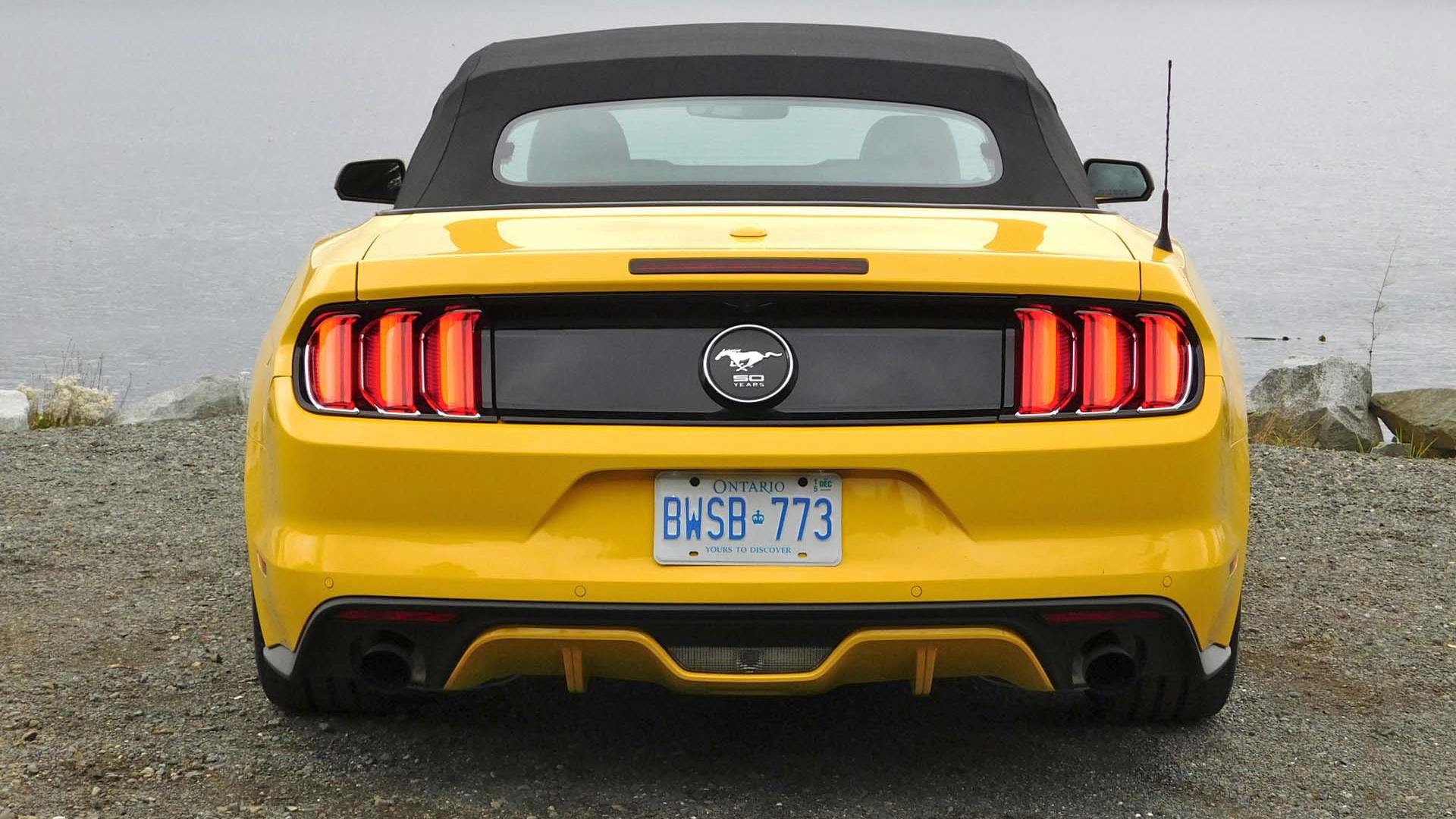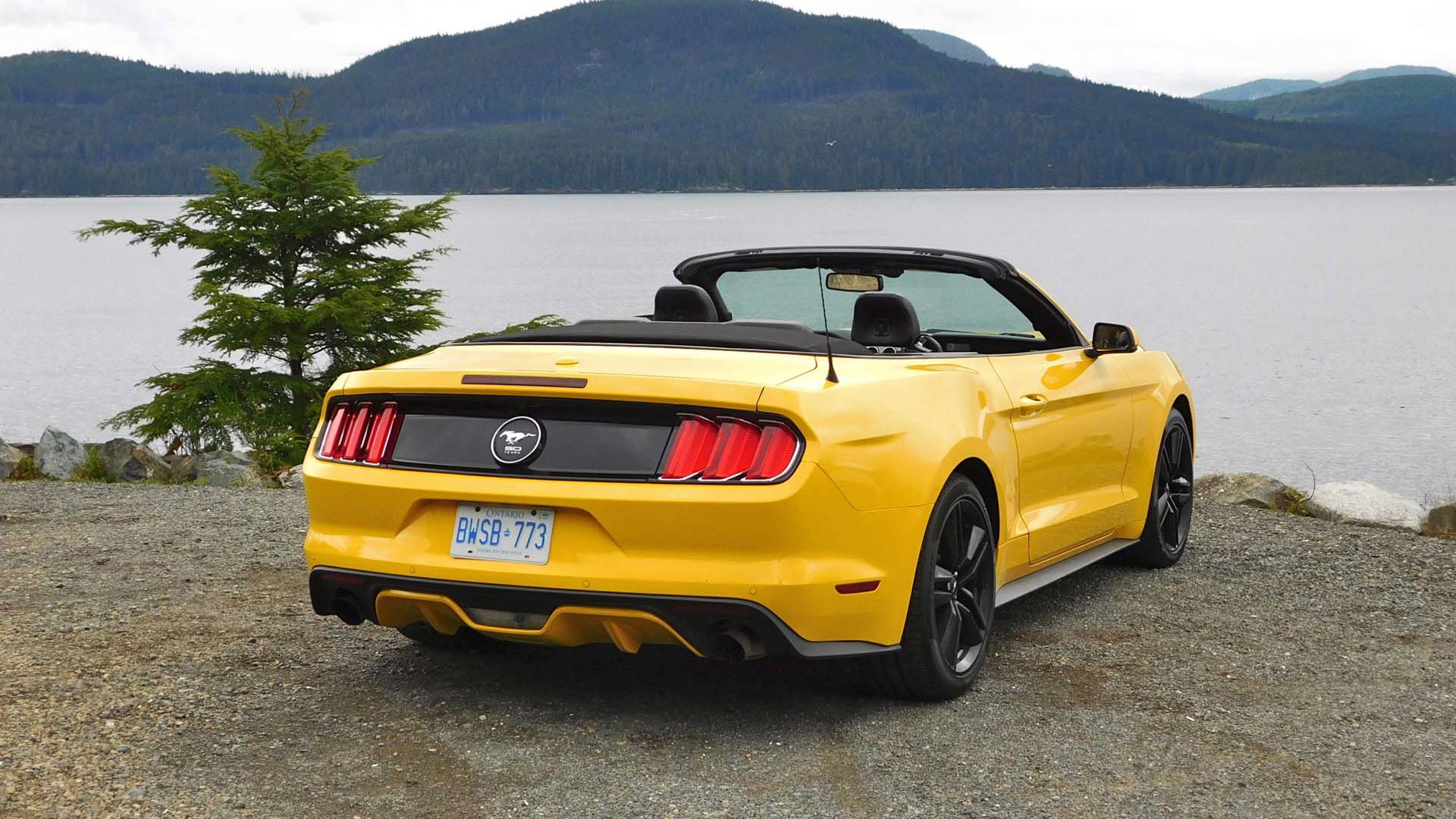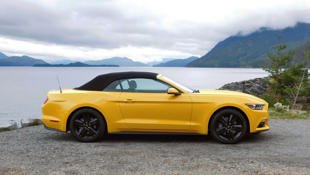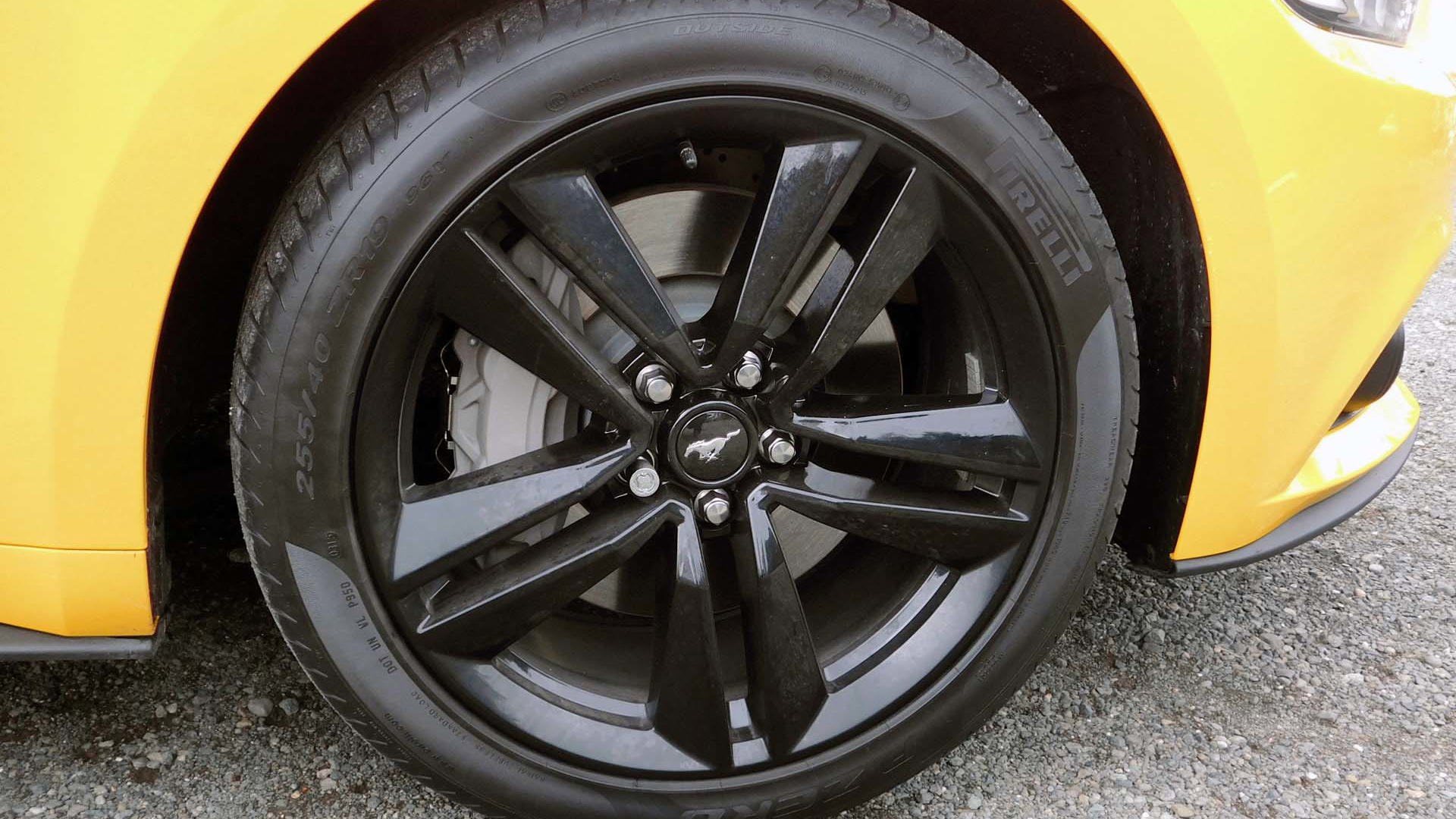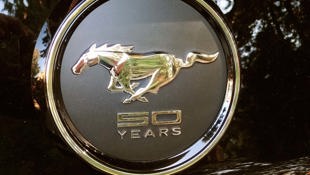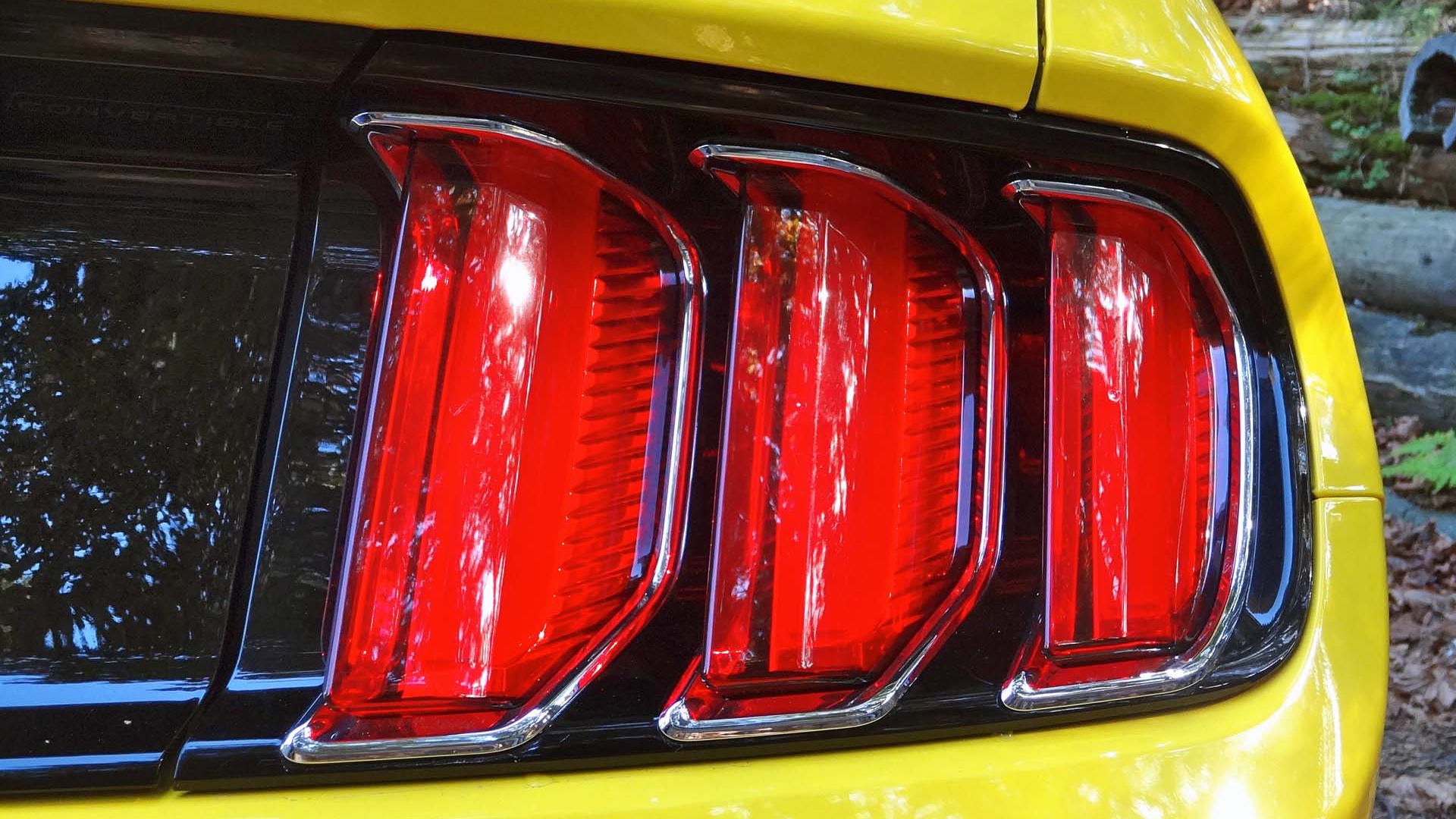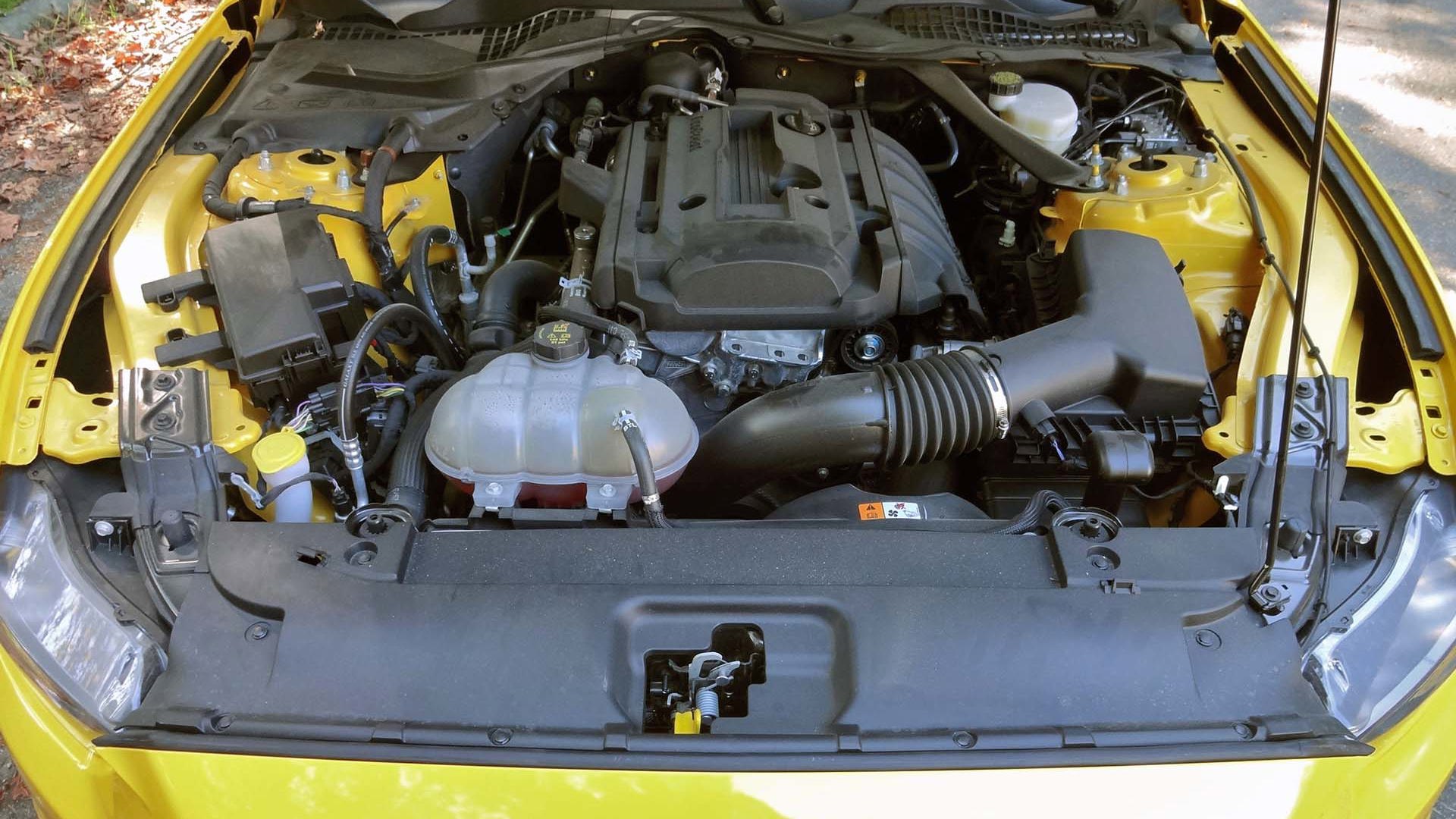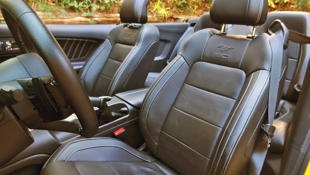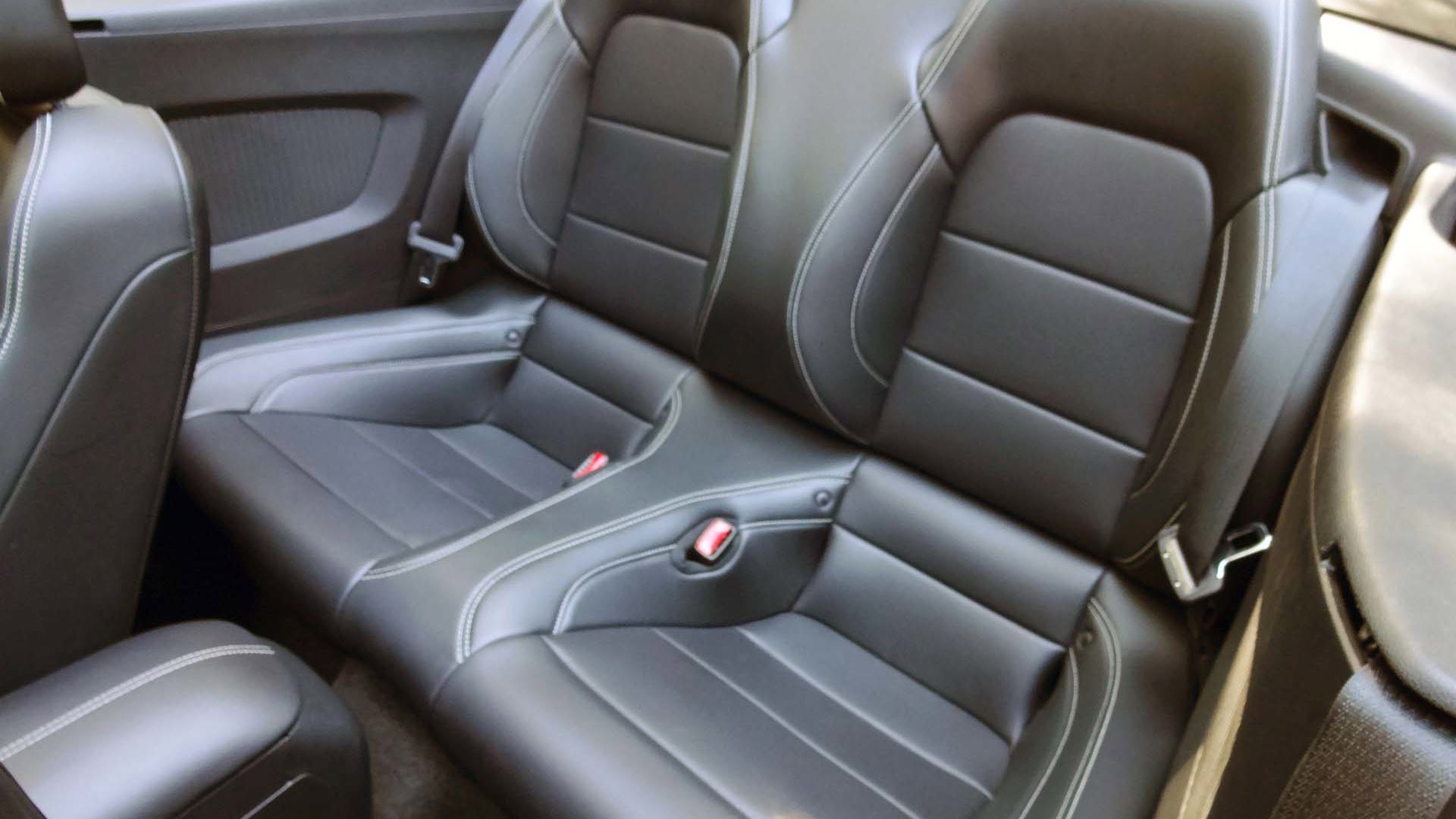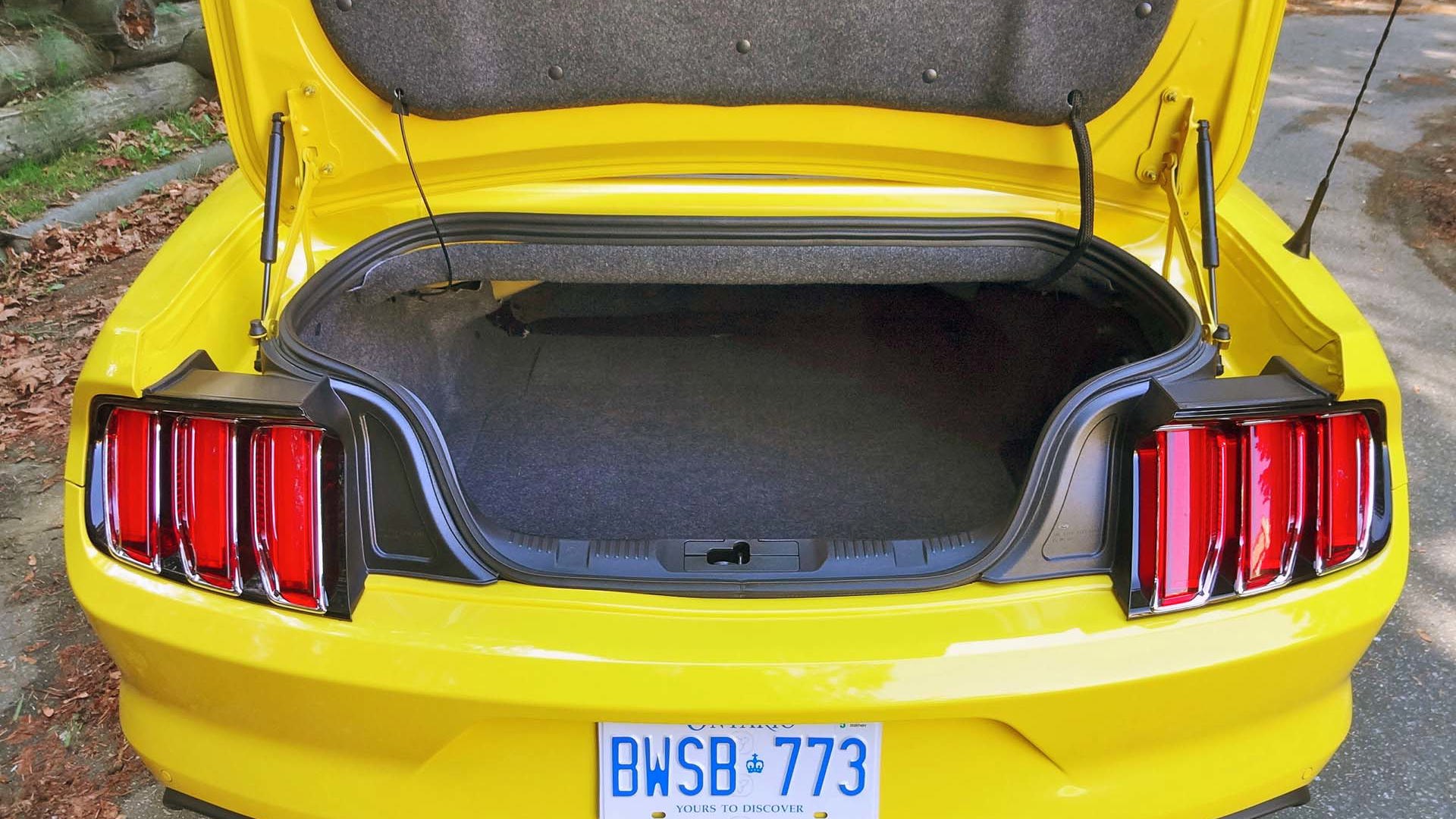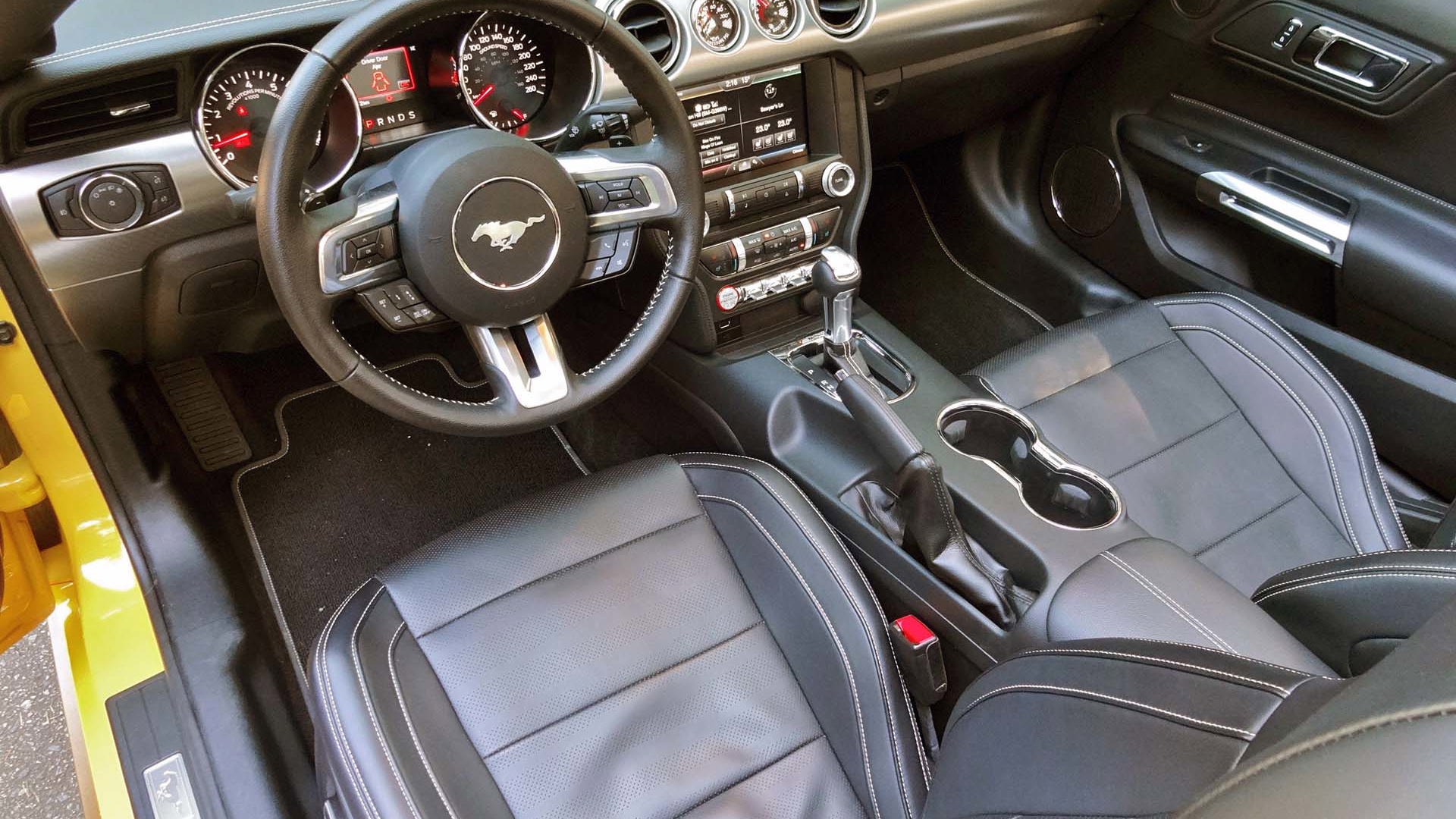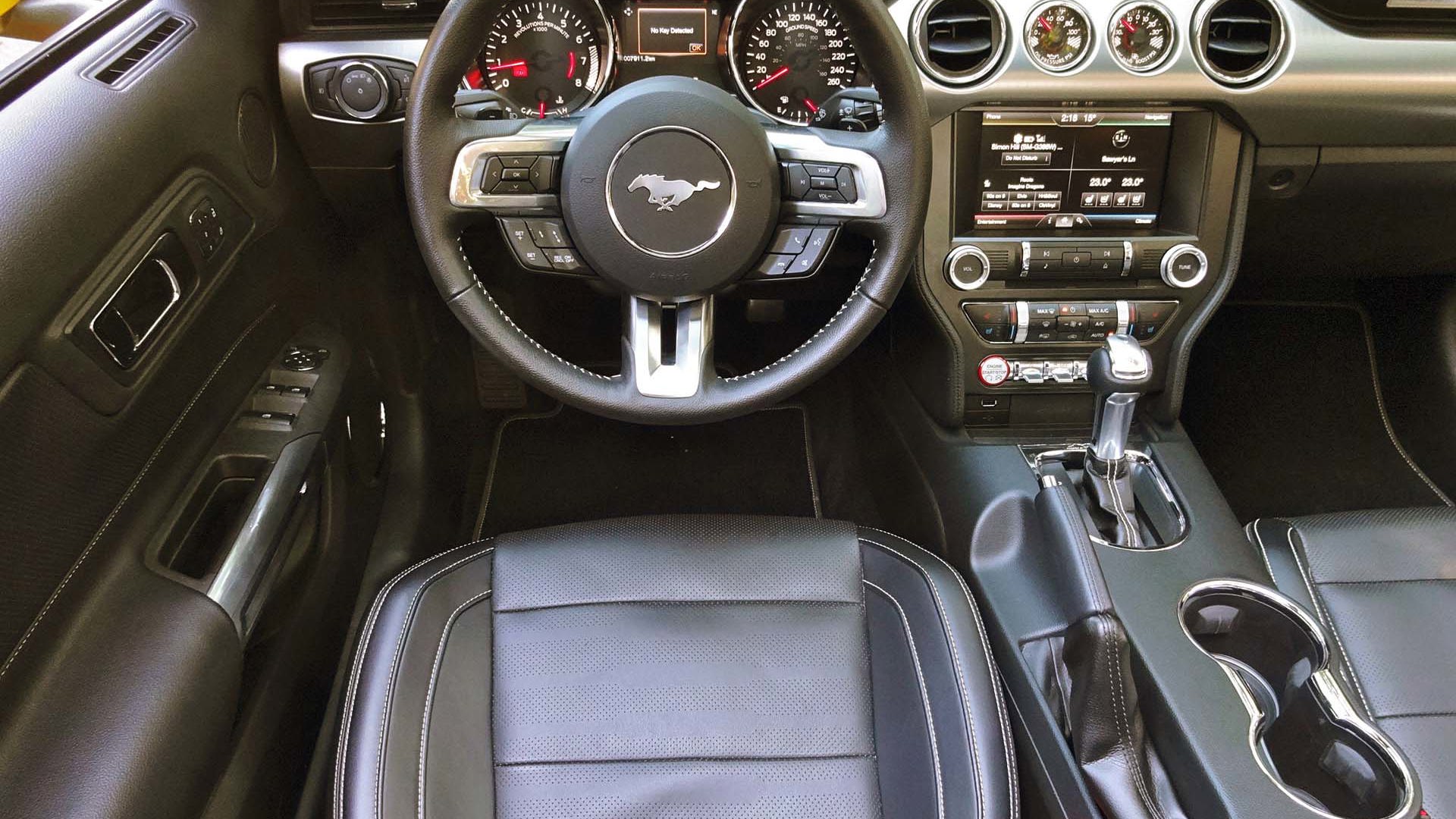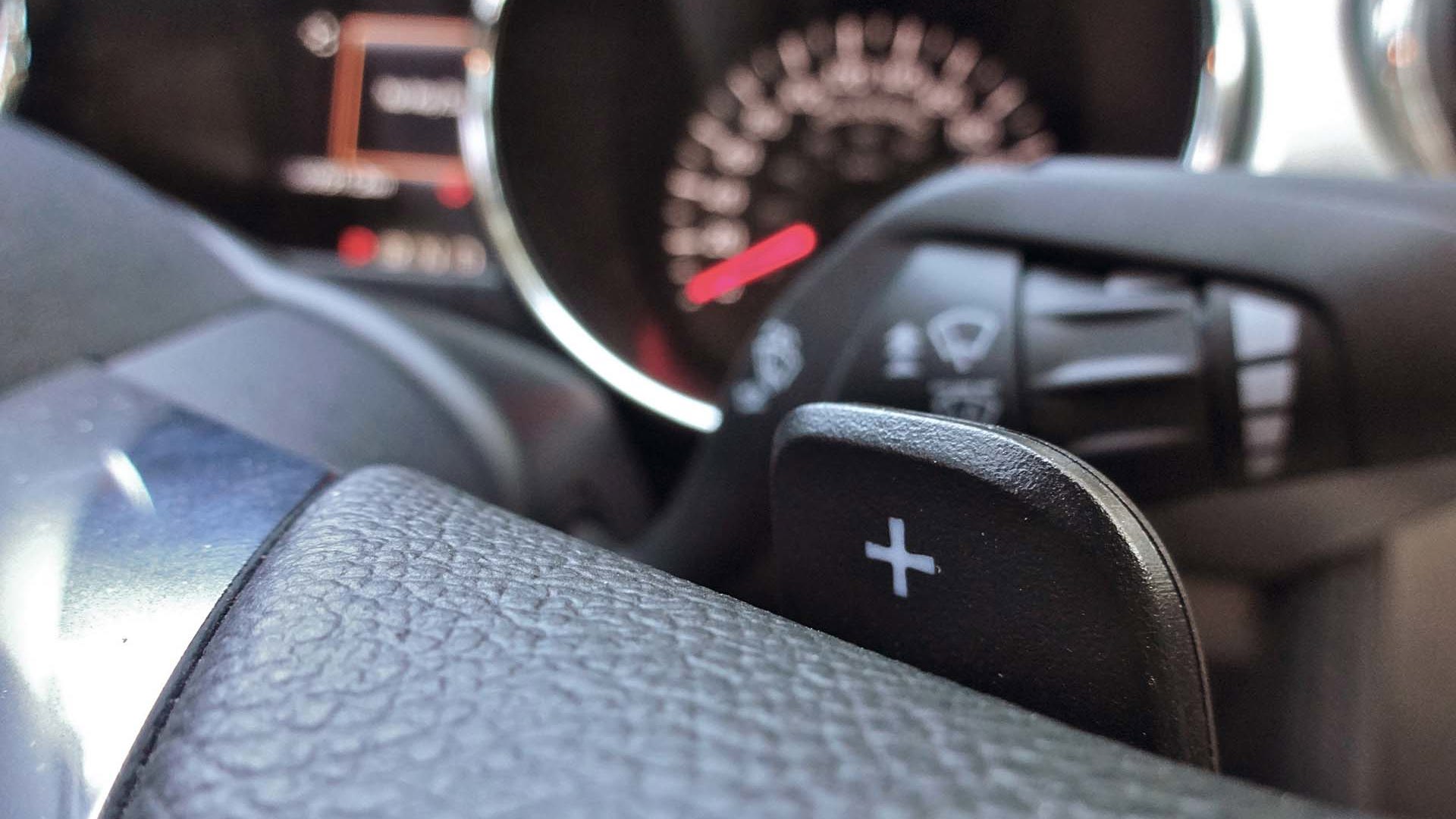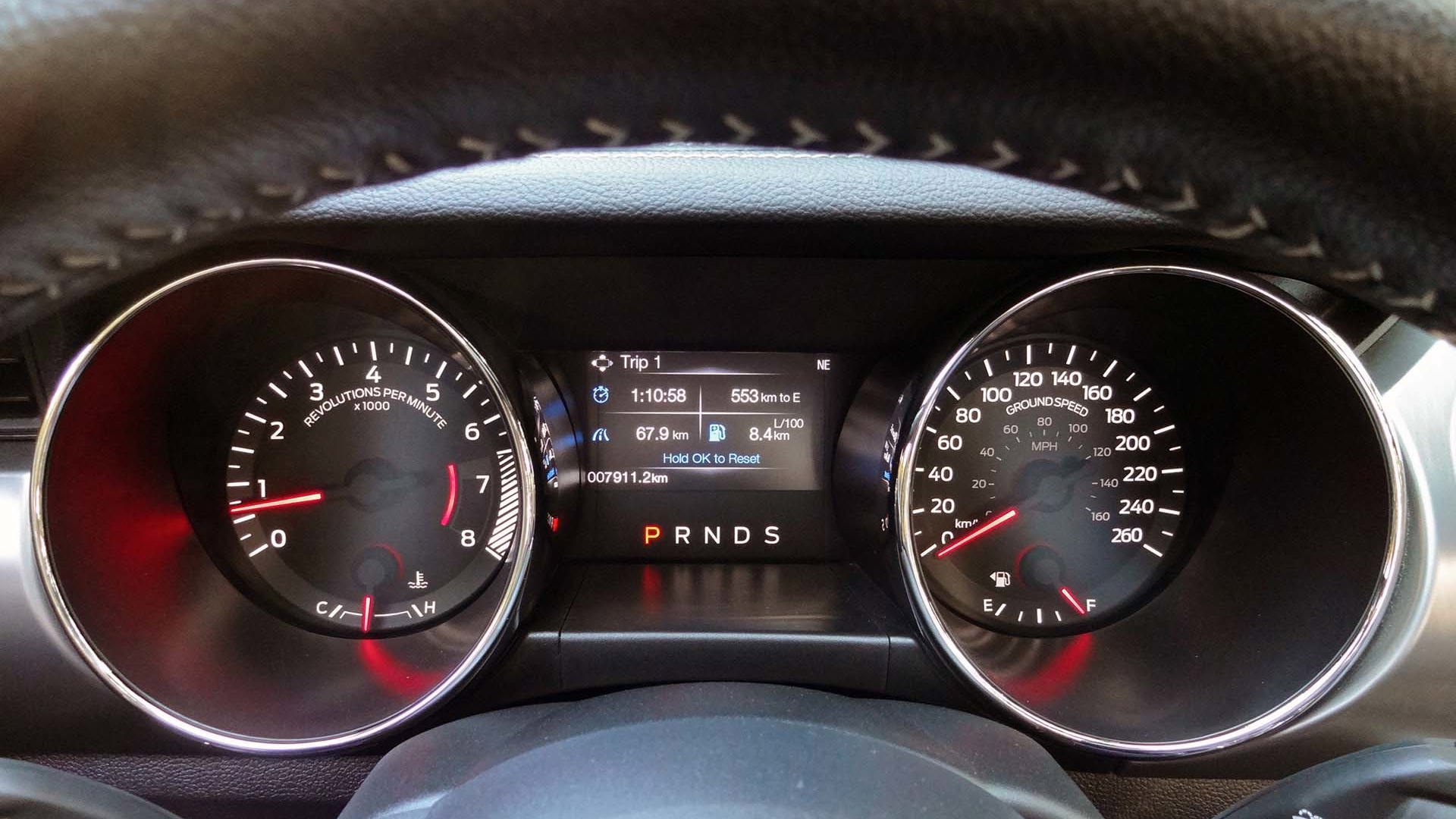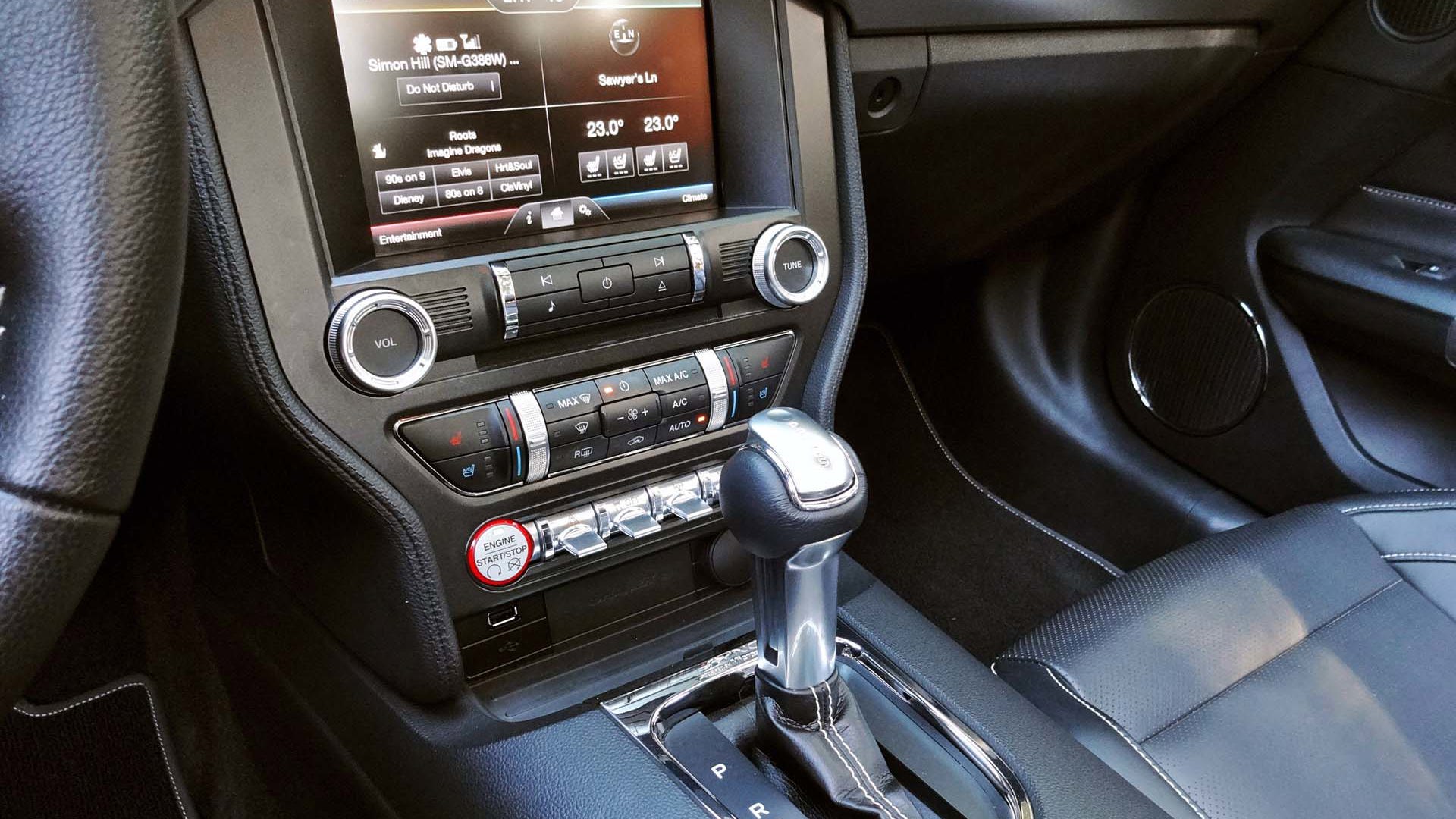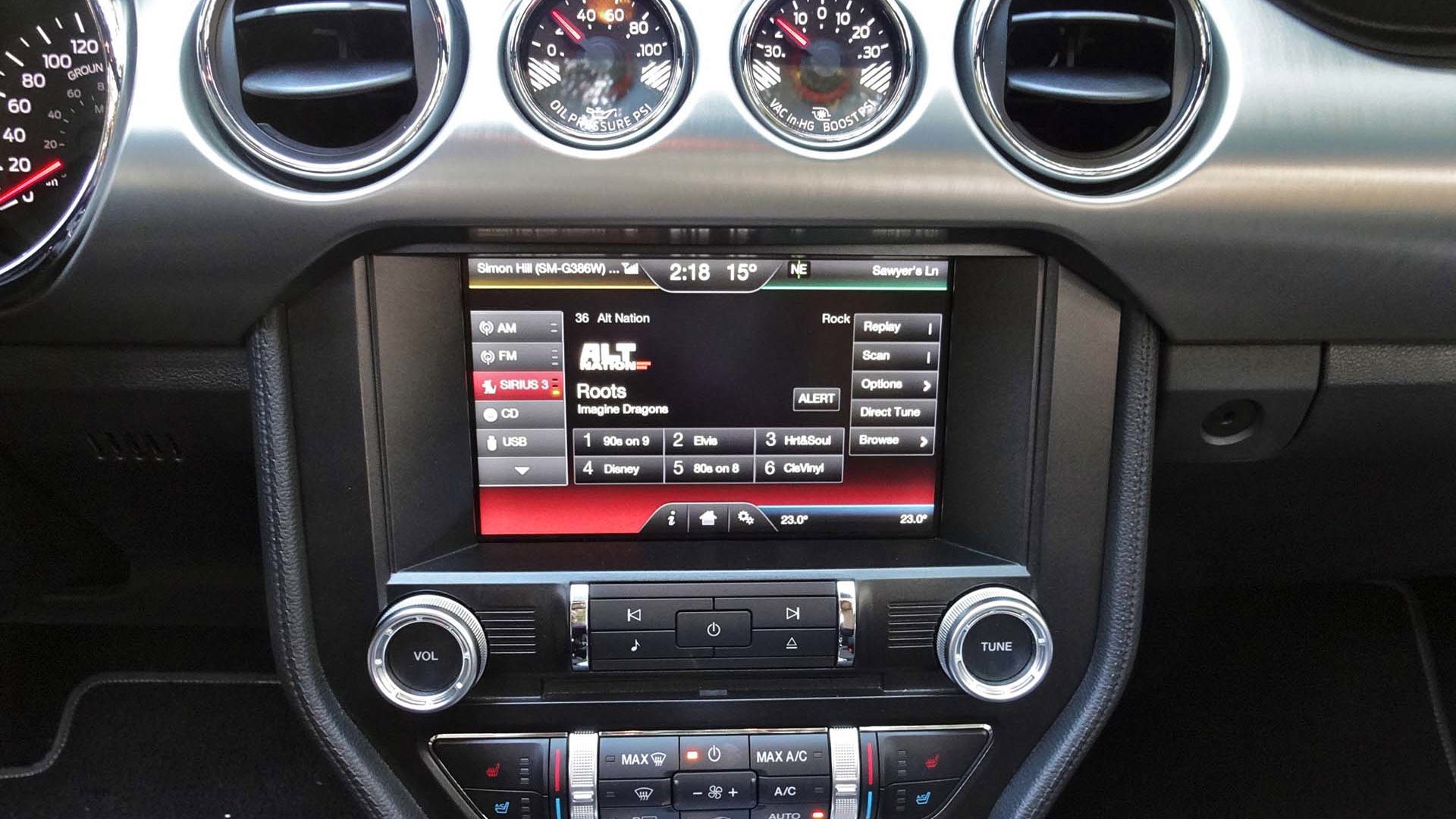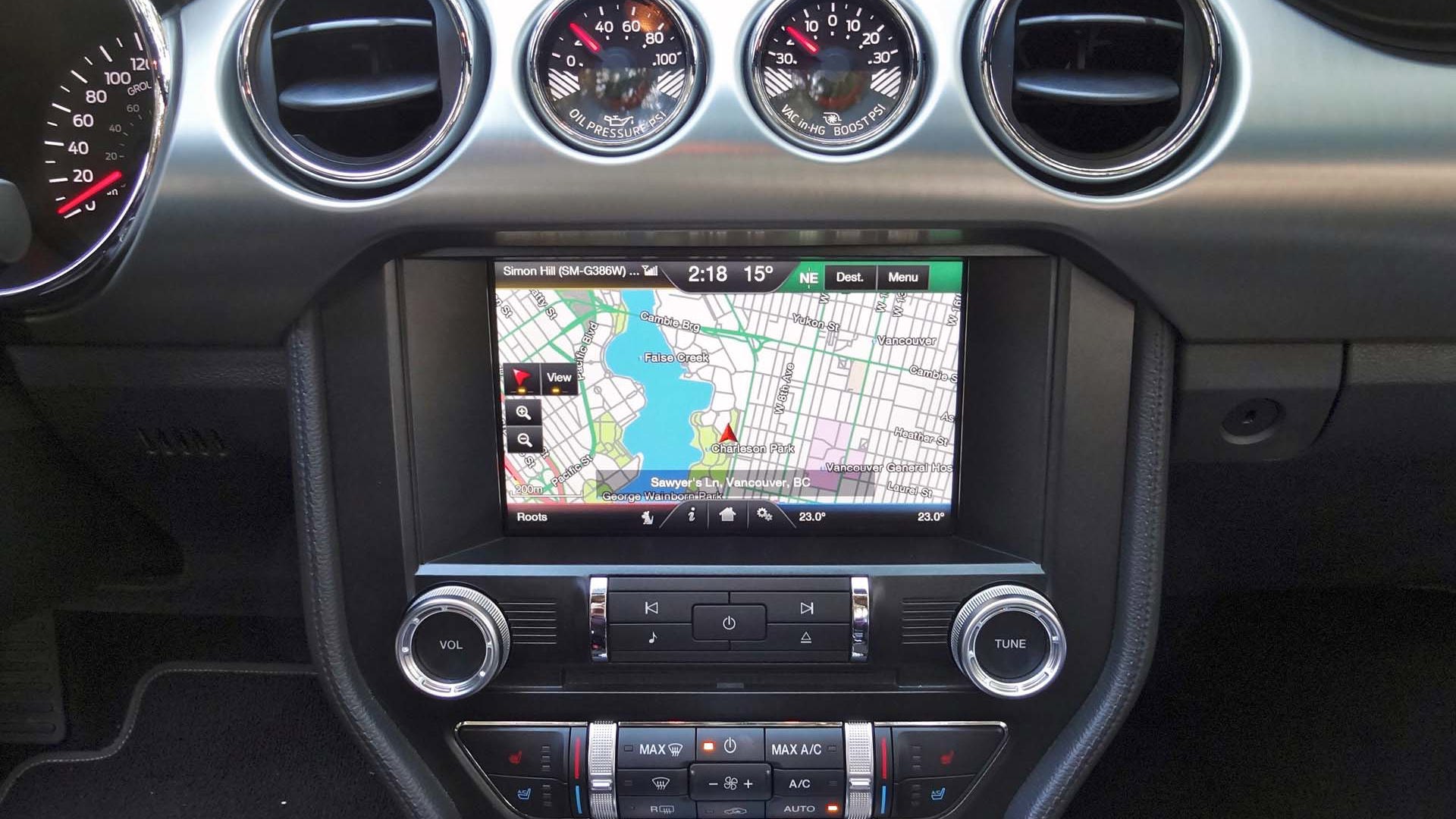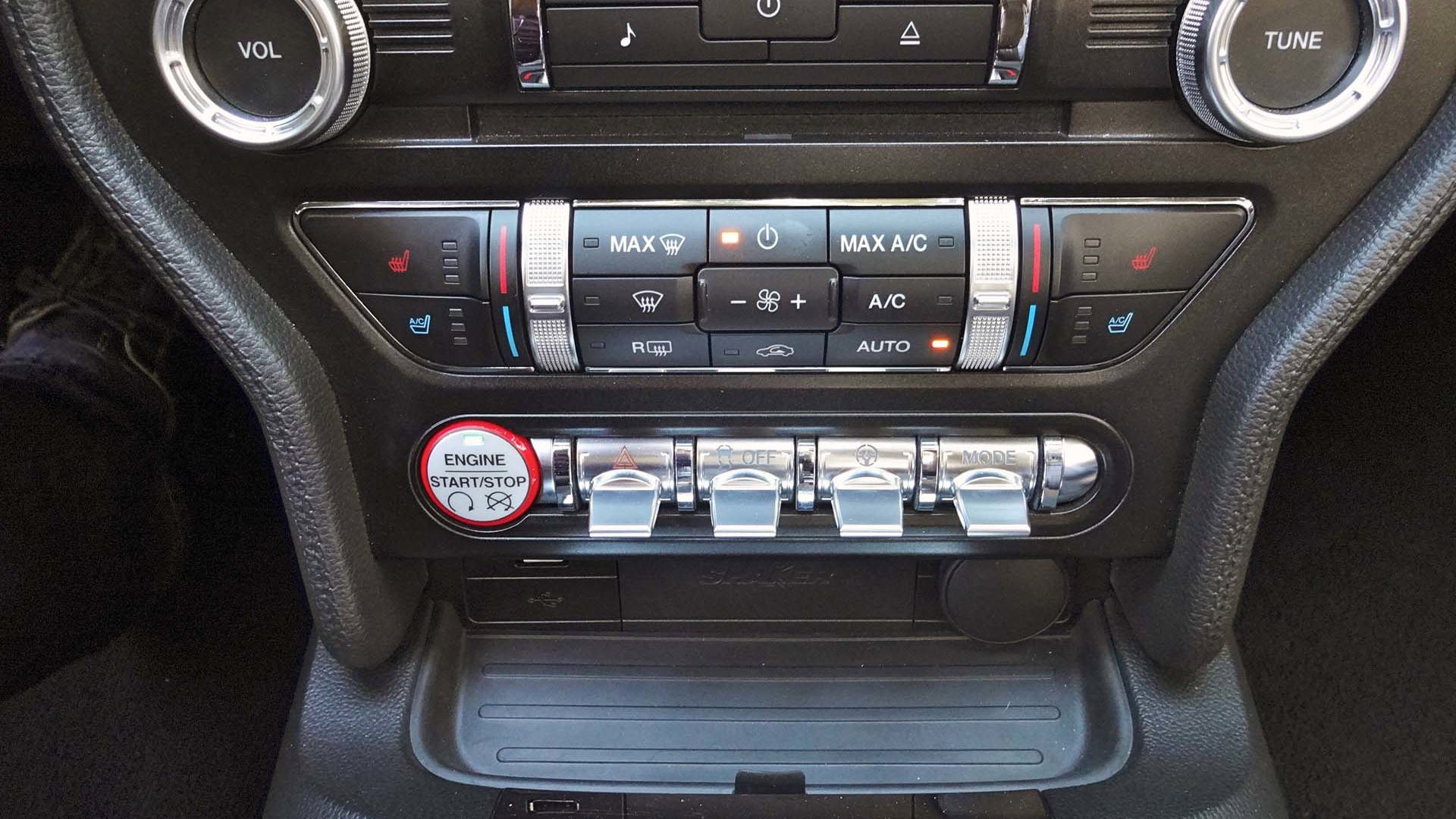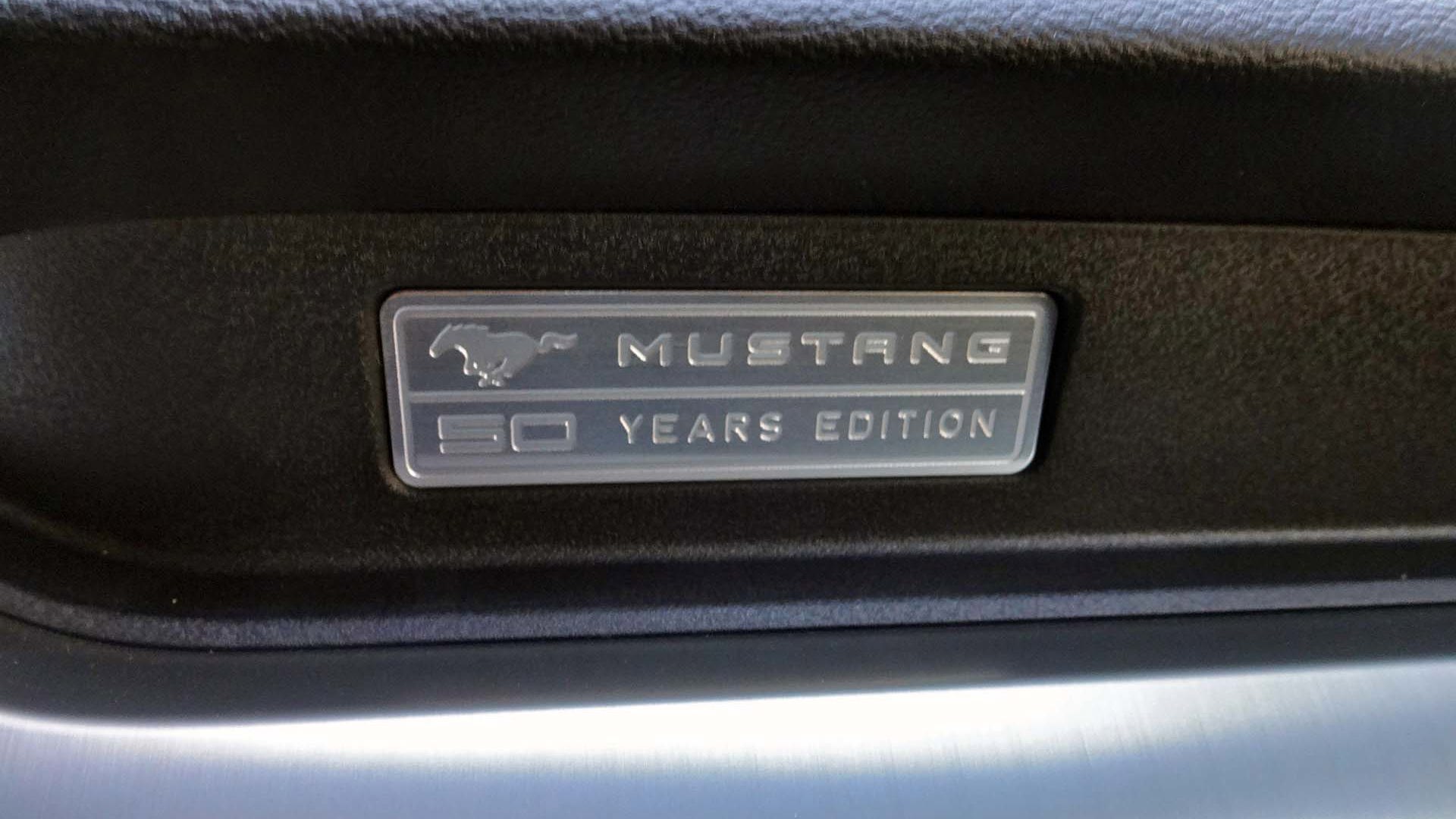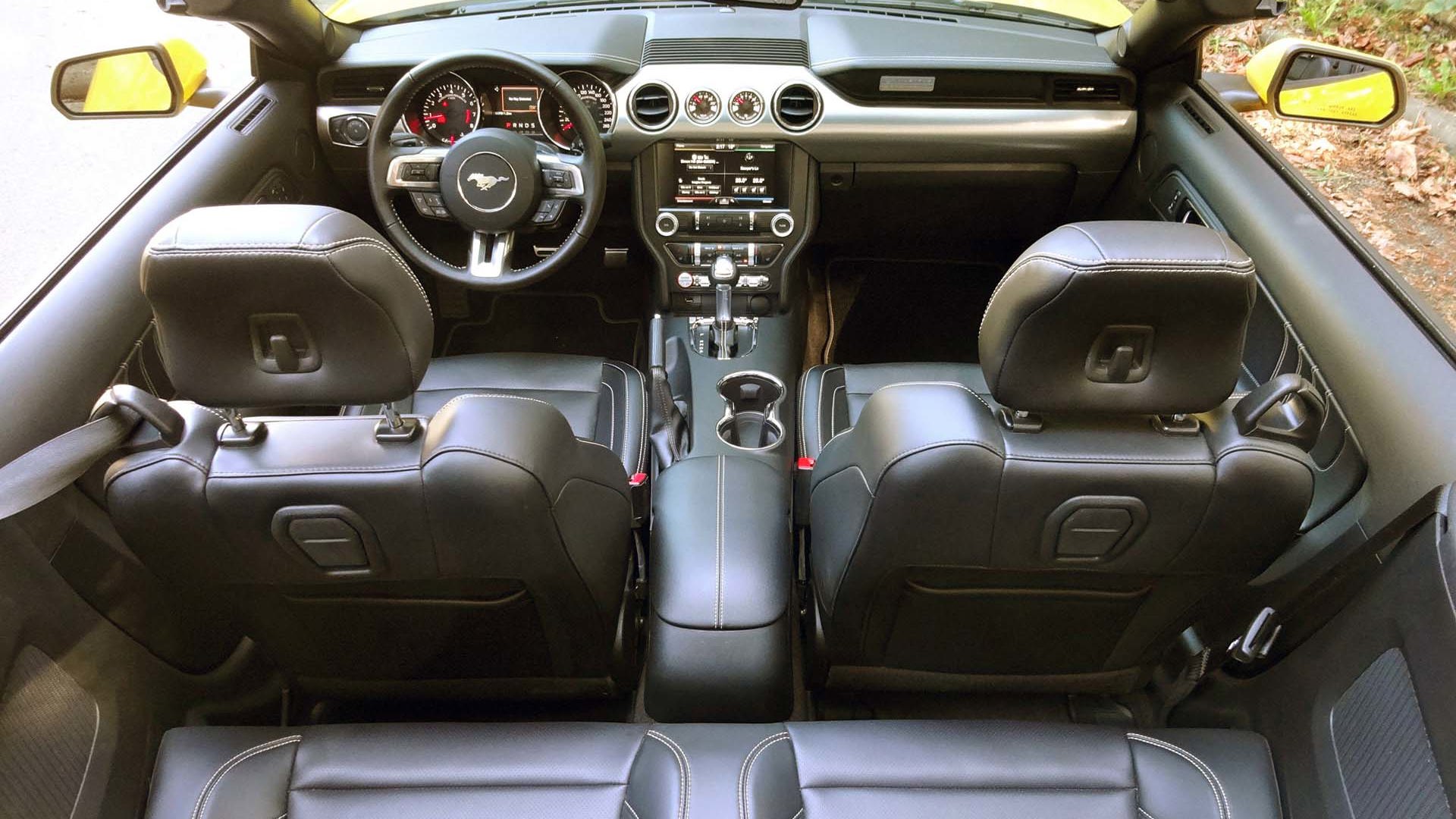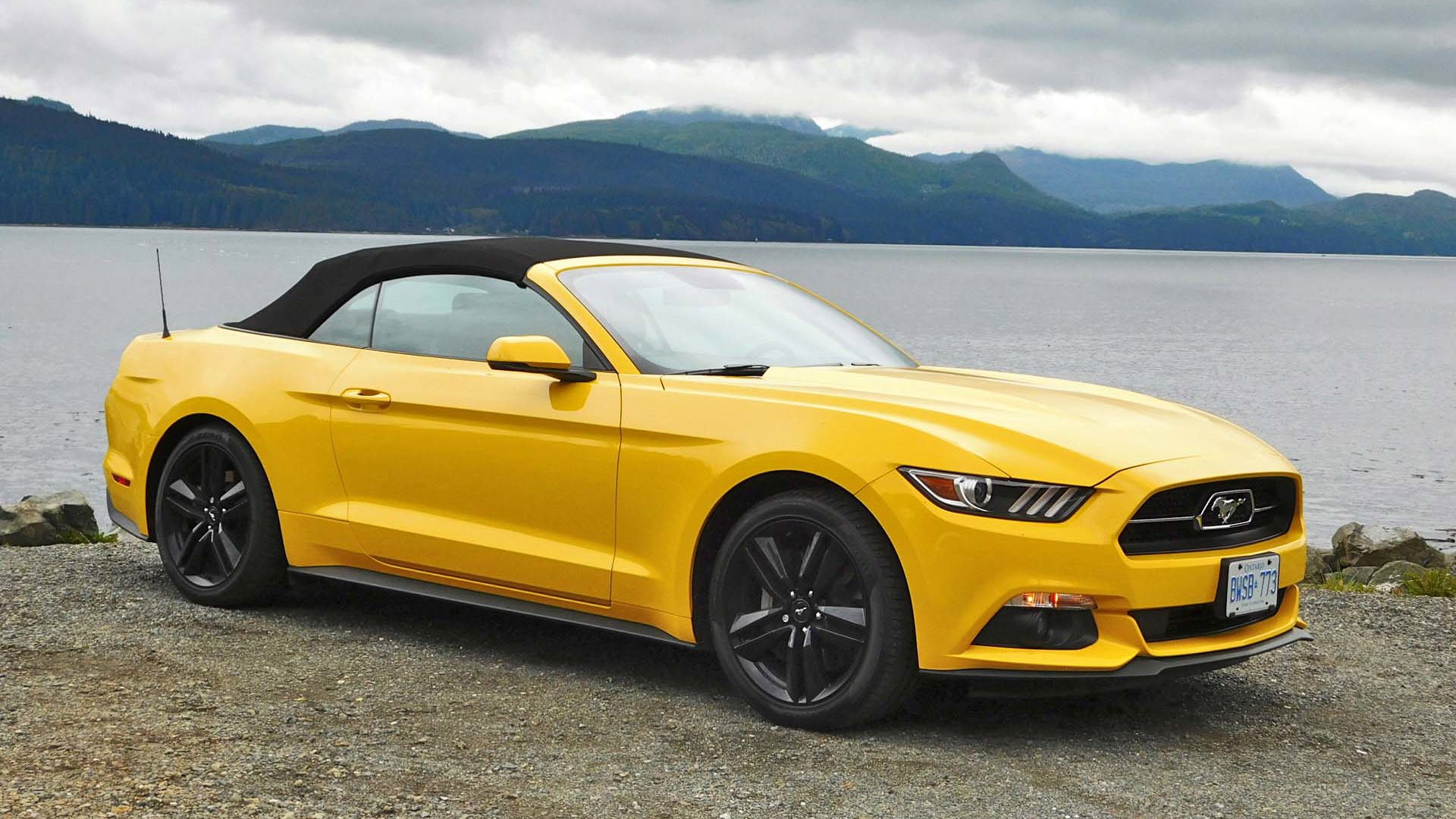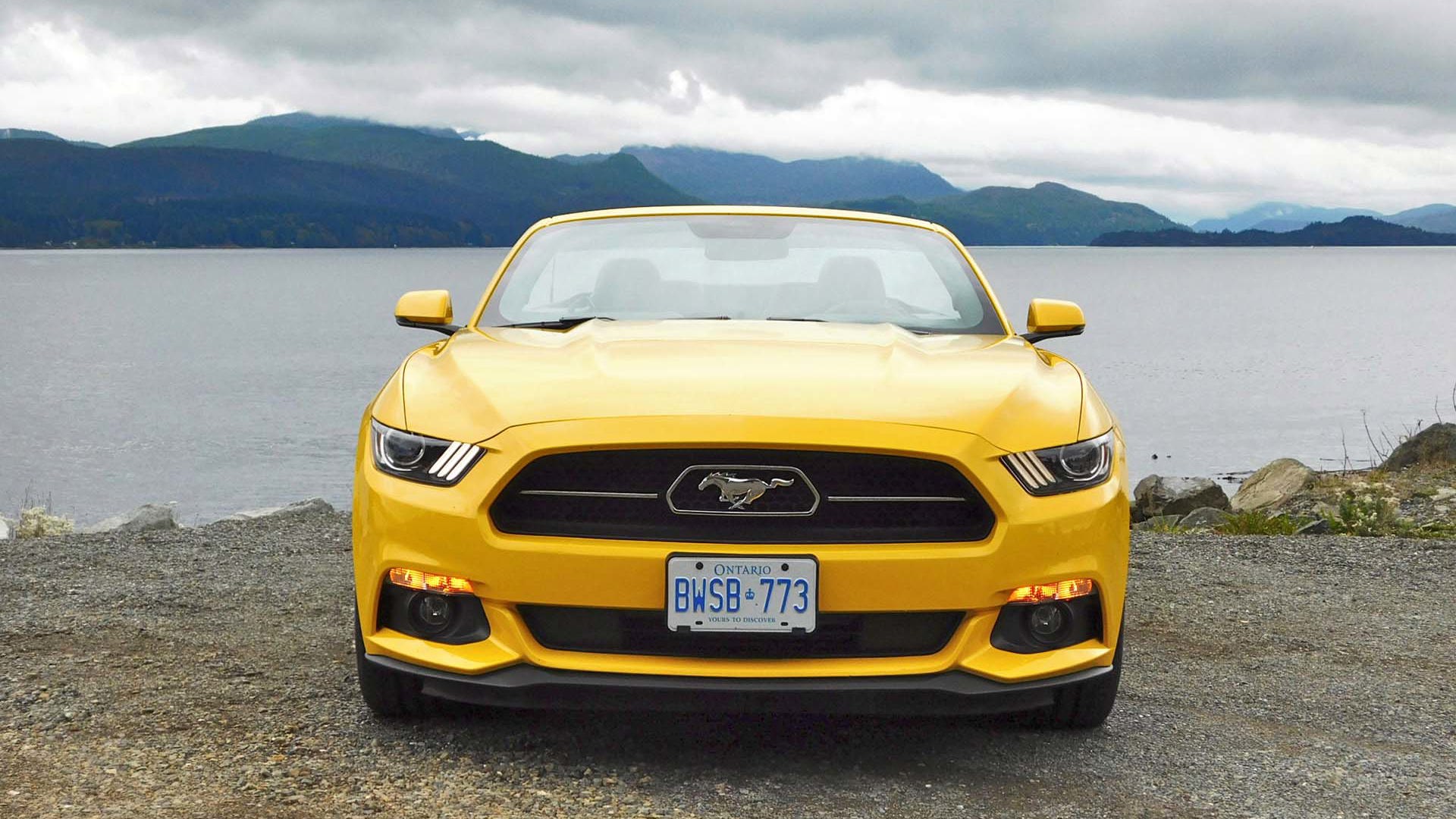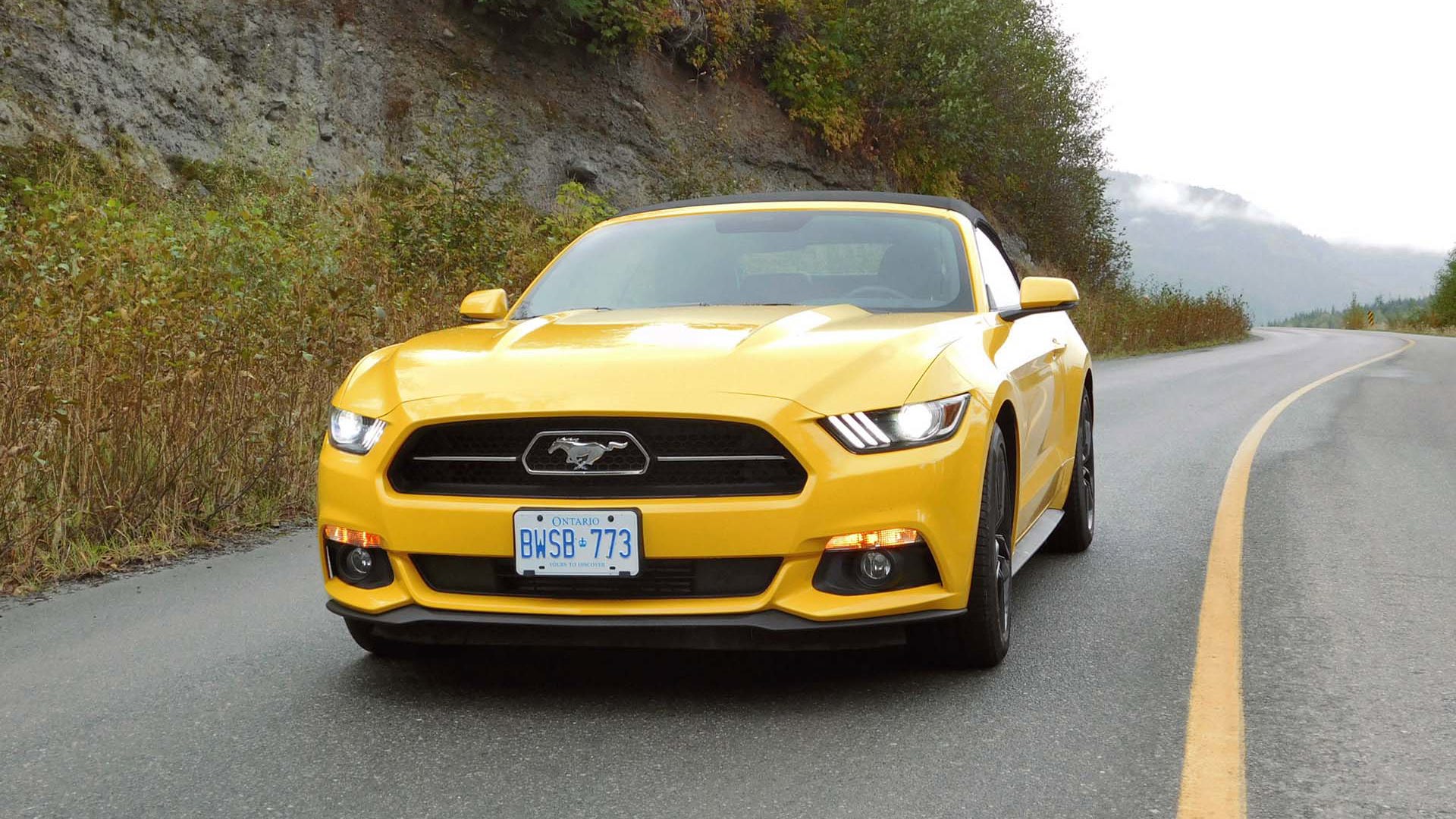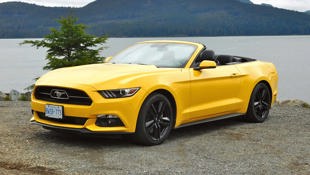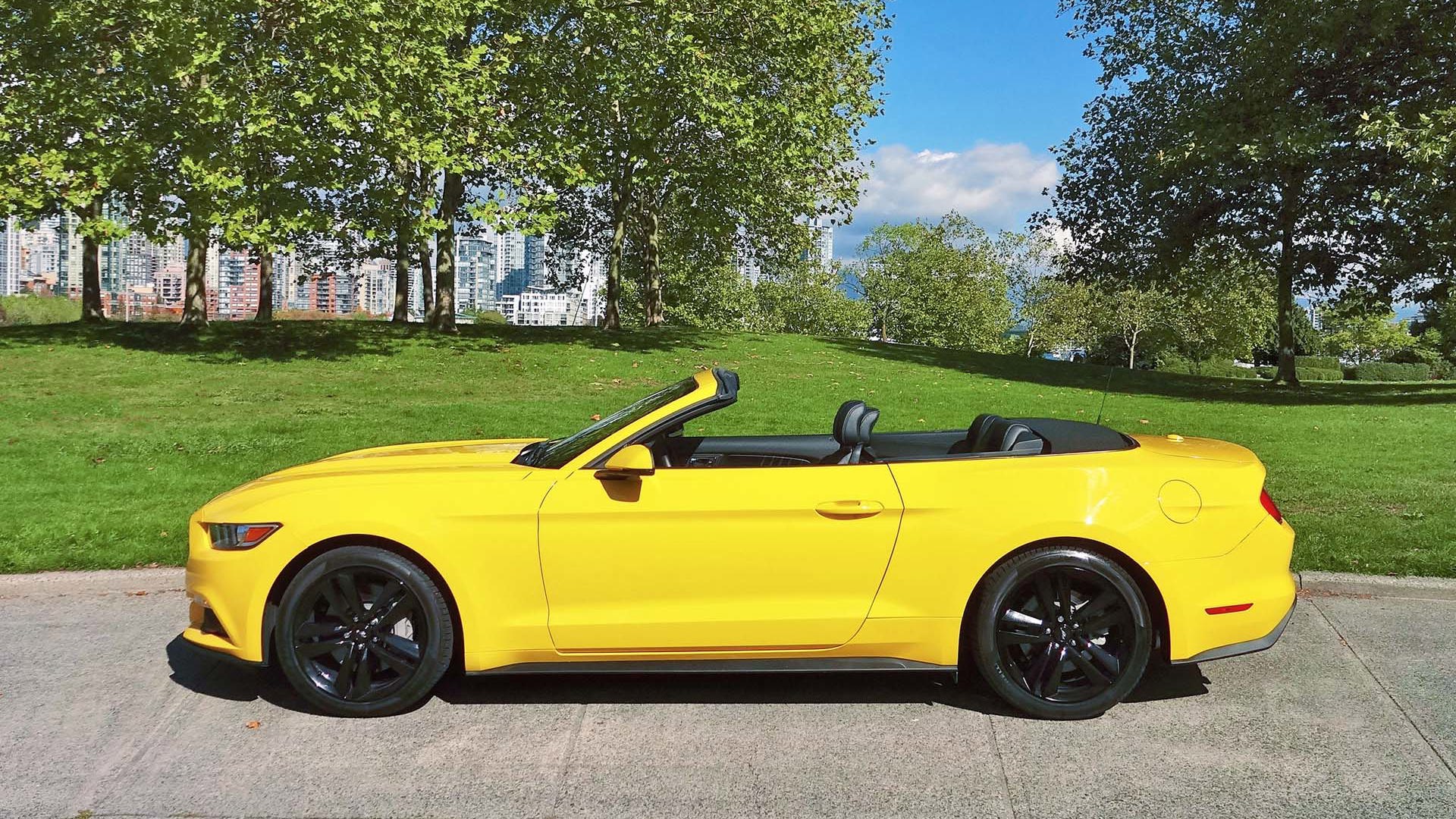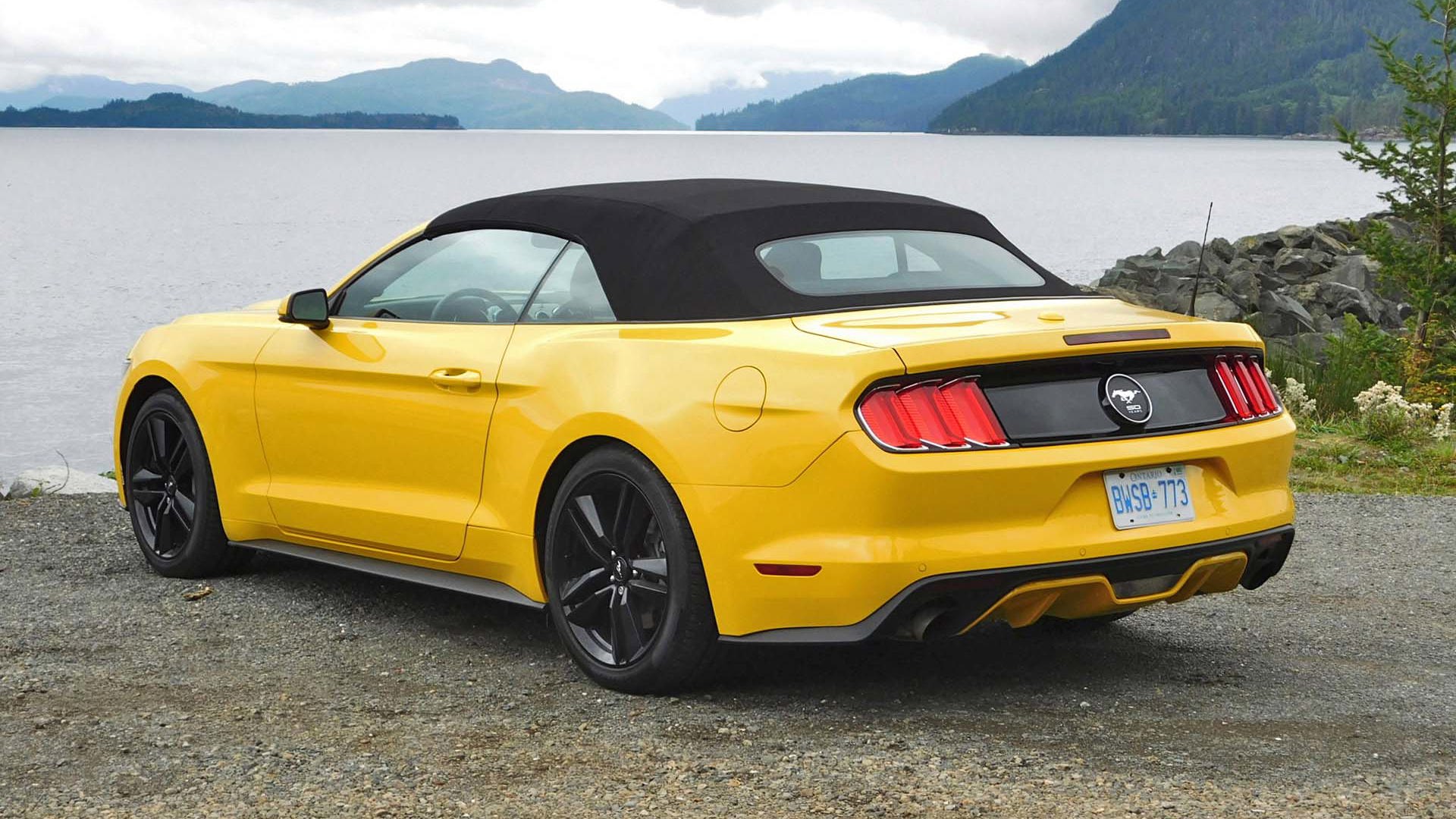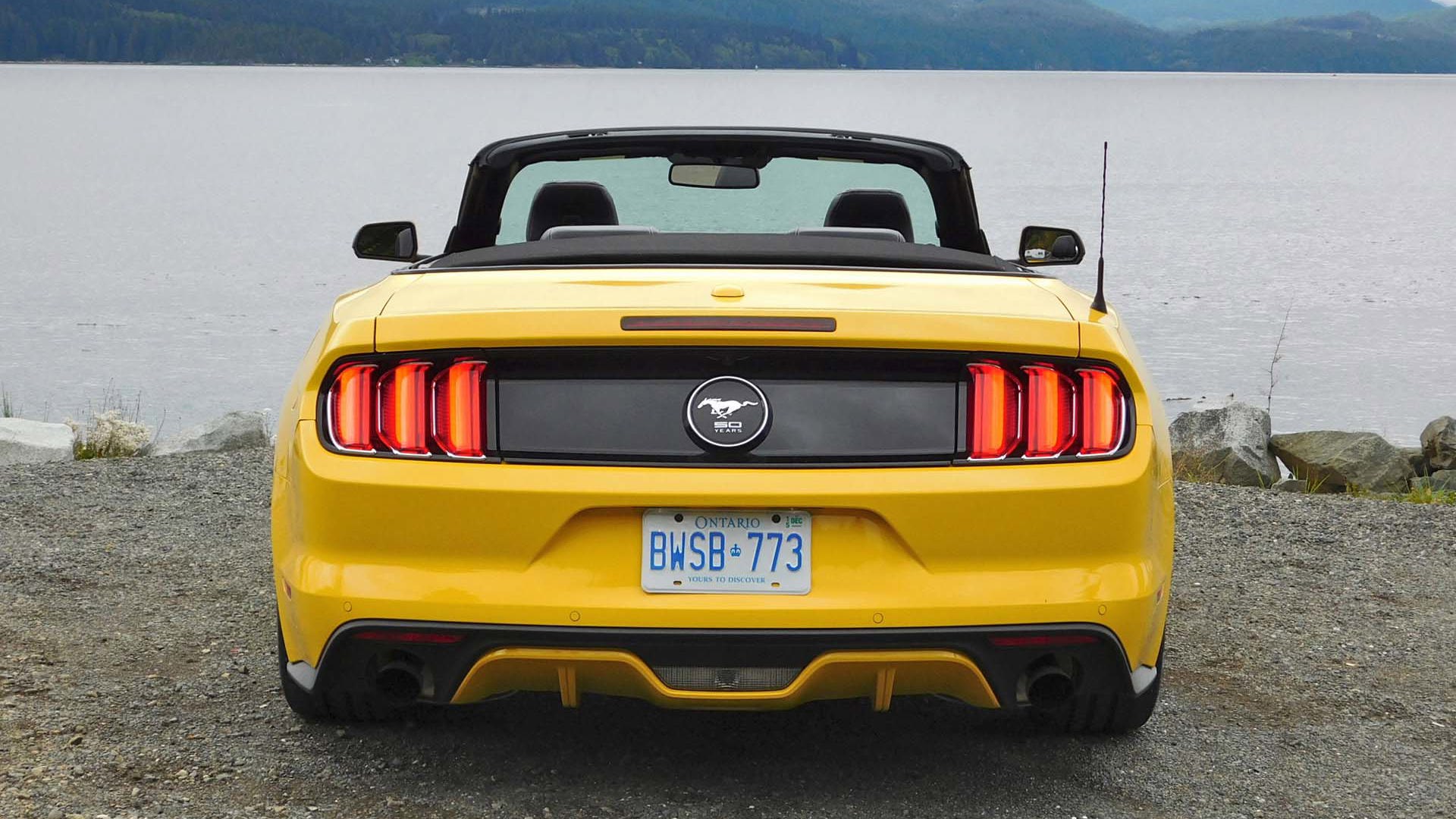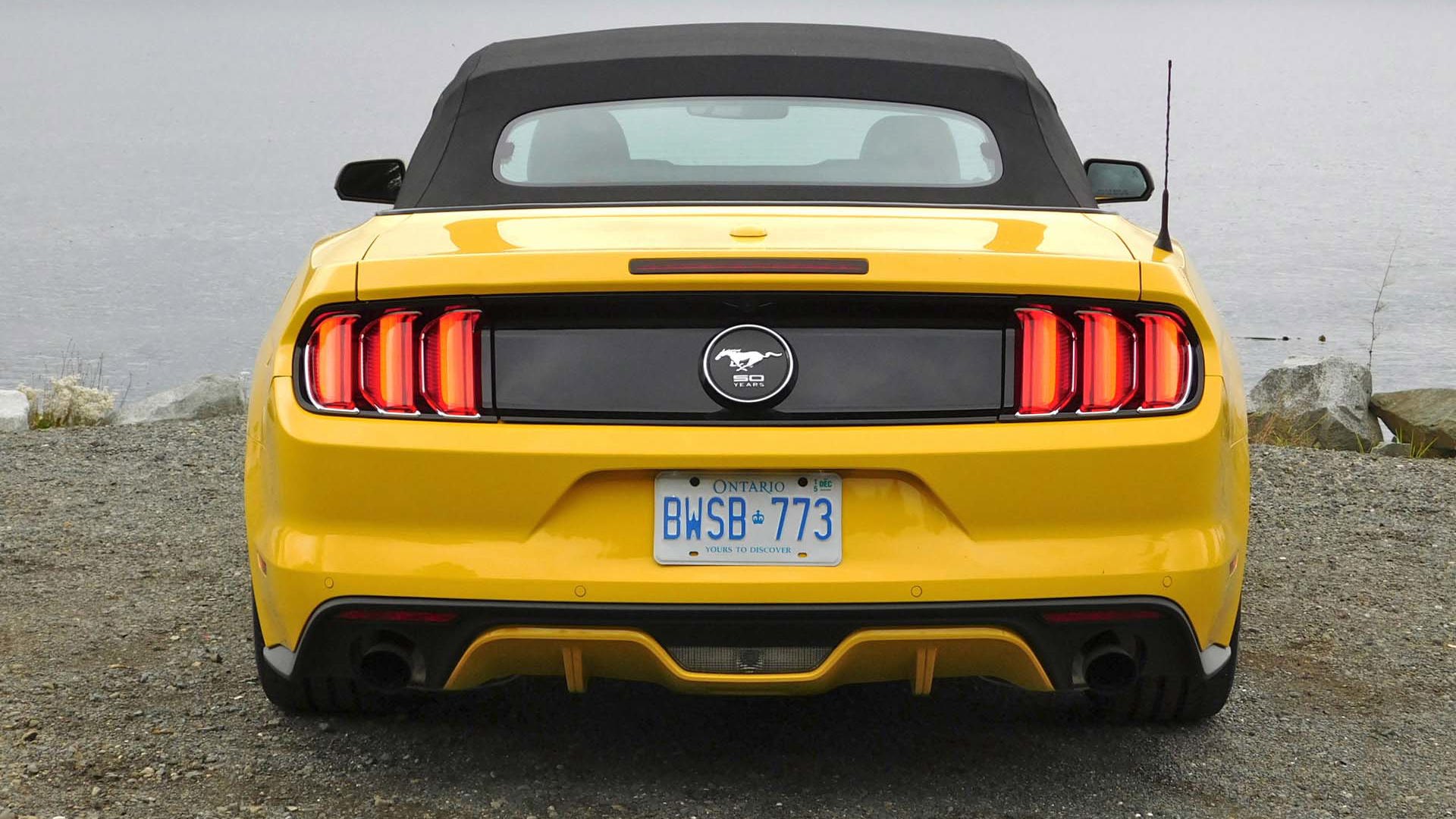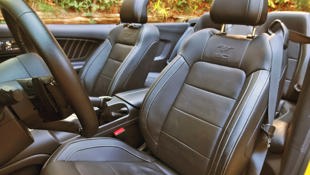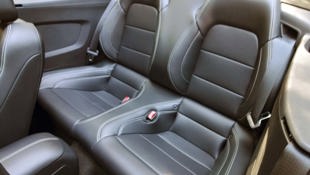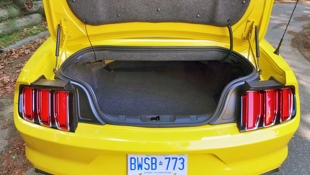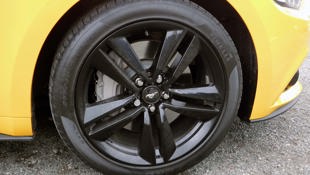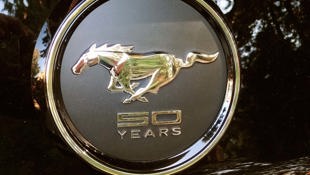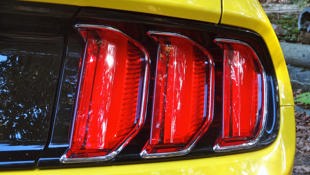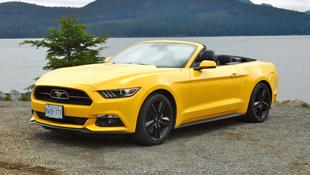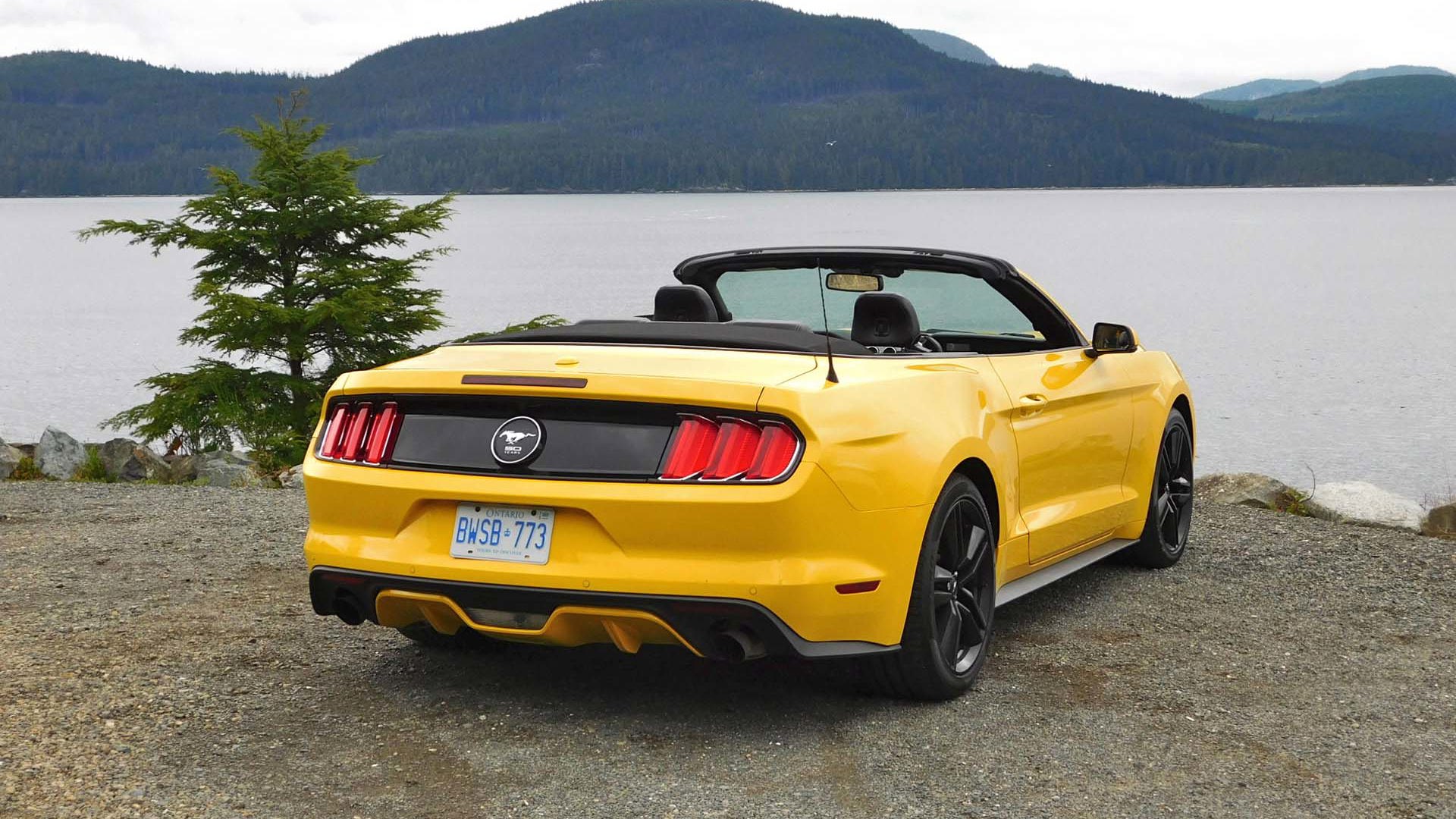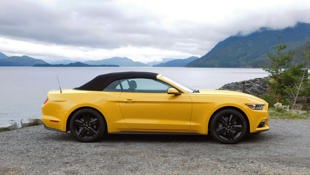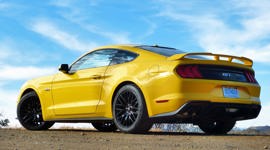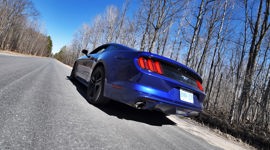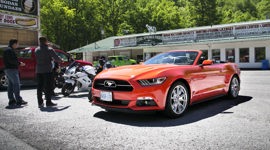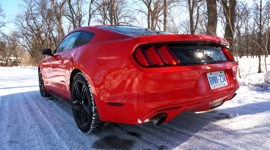Okay, let's get this straight right off the top: The redesigned sixth-generation 2015 Ford Mustang Convertible, fitted with the twin-turbocharged 2.3L four-cylinder EcoBoost engine, is a great car.
Let's not get all wound-up complaining that Mustang's new-for-2015 EcoBoost engine is the emasculation of the North American muscle car. It's not.
It has an attention-getting physical presence with all the visual drama expected of a top-trim Mustang. It has a modern new independent rear suspension that, combined with the four-cylinder engine's lighter front-axle weight versus the V8-powered Mustang GT, gives the EcoBoost Mustang genuine handling chops and a fun-to-drive demeanour. It makes plenty enough power, with 310 horses and 320 lb-ft of torque on tap under your right foot, delivered in a rapid, linear rush. It's luxurious, with all the available bells and whistles you could possibly wish for. And it's even reasonably practical for a sports drop-top, with comfortable front seats, tolerable back seats, a decent-size (323 litre) trunk, and surprisingly good fuel economy – at least when you're not flogging it.
It's also not the first time a four-cylinder engine has been offered in a Mustang: The third-generation Mustang of 1979-1986 used a 2.3L four-cylinder as its base engine, and even offered a performance-oriented turbocharged four-cylinder from 1984-1986, called the Mustang SVO.
So let's not get all wound-up complaining that Mustang's new-for-2015 EcoBoost engine is the emasculation of the North American muscle car. It's not. It's more like the Europeanization of the North American muscle car (is that even a word?), and if you're Ford and you're trying to compete with European and Japanese marques both here and abroad, there's nothing wrong with that. It means that the sixth-generation Mustang can be sold worldwide for the first time in the model's history (it's being sold in both left-hand and right-hand drive in over 100 markets around the globe), and it means that in North America, Ford can offer a version of the Mustang that might just tempt potential buyers of Audi and BMW Cabriolets into the Ford fold. More choice is good, and hey, if you still want the big, rumbling V8 it's just an option-tick away.
In the case of my test car, Ford ticked not just the EcoBoost option box, but pretty much every other option you can get with this powertrain. For the convertible, the EcoBoost powertrain comes only in Premium trim (the Fastback EcoBoost can be had in standard or Premium trim), and on top of this Ford loaded my test car up with the $1,600 automatic transmission, a $2,000 Equipment Group 201 package (adding Shaker audio system, memory driver's seat and mirrors, and blind spot information system), a $1,600 adaptive cruise control package, a $3,000 EcoBoost performance package (adding 19-inch wheels and 3.55:1 limited slip differential), $350 reverse park assist, $800 navigation system, $1,700 50th Anniversary package, and $550 tricoat yellow paint. We'll get to the total cost later, but for those doing the math, that's a whopping $11,500 worth of options.
From the beginning: Evolution of the Mustang
Inside, the new Mustang retains the classic "dual cowl" cockpit styling while raising the bar significantly in terms of materials and finish compared to the previous-generation models. Rigid plastics still make up things like the console sides and lower dash, but overall the materials appear more luxurious, and soft-touch surfaces abound. My test car featured a stitched leather-look dash top with milled aluminum trim running the width of the dash itself, and playful touches include aircraft-style (some might say Mini-style) toggle switches for several functions (the hazard lights, traction-control defeat, steering mode and drive mode). Speaking of playful touches, my test car was also fitted with exterior puddle lights that project the Mustang emblem onto the ground when you touch the door handle.
A big colour touchscreen takes care of infotainment functions, and Ford's Sync user interface has evolved to become equal to or better than most competing systems in terms of ease-of-use, even if a few of the touch-points are a wee bit on the small side (the zoom buttons on the navigation screen in particular gave me trouble). Cabin storage space is also on the shy side, but adequate enough with a small console bin, a pair of cupholders, and useful door cubbies. The Shaker audio system doesn't offer quite the clarity or presence associated with systems from Bose or Harmon Kardon, but it does offer deep bass response and plenty of volume. In practical matters, I was happy to find that Ford has included large traditional volume and tuning knobs for the basic audio functions. Hallelujah!
The deeply-bolstered, leather-upholstered front seats provided reasonable comfort for my 5'11", 160-lb frame over the course of a three-hour road trip, and held me nicely in place when cornering with enthusiasm. In my top-trim test car the seats were not only heated but ventilated, which was nice when the sun came out. The back seats in a sports car are often a bit of an afterthought, and the Mustang is no exception, but rear legroom is actually somewhat better than it might appear in the photos: there's quite a deep scoop in the front seatbacks, and this provides additional room for rear passenger's knees. I crawled into the back seat and found that I could indeed sit behind myself – perhaps not exactly in supreme long-distance comfort, but not in any real discomfort for shorter trips.
Ford has made much fuss about its new quick-folding electrically-operated top, and indeed it is pretty quick (about 10 seconds up or down), and it folds neatly to form its own cover when stowed. But you have to stop the car before operating the top, and the header latch must be released and engaged manually. I found it slightly irritating that there's no chime or anything to indicate when the power top operation is complete, so there's a tendency to sit there holding the button for several seconds after the top finishes doing its thing. I also didn't like that the windows automatically lower prior to the top operating, but don't automatically raise up again, so if you want the windows up that adds another step to the process. On the plus side, the insulated, twin-layer top offers decent insulation and soundproofing (so it's reasonably quiet at highway speeds), it has a proper glass rear window (rather than plastic), and when up it interferes far less with rearward visibility than many other convertibles I've driven. All of this means that when the top is up, you can sometimes forget that you're actually driving a convertible.
Ford claims to have increased the structural rigidity of the sixth-generation Mustang Convertible by some 15 percent compared to the previous generation, and after having driven the car on washboarded gravel roads with the top down, I'll believe it's at least that much stiffer. The dreaded convertible "cowl shake" (the tendency for the body to flex around the strong point formed by the front firewall) is well-enough controlled as to be hardly discernible – more of a "cowl quiver" really – and then only on the nastiest sections of road.
Whether on washboarded gravel roads or smoothly twisting blacktop, the sixth-generation Mustang's integral-link independent rear suspension gives this pony car a whole new level of poise and surefootedness – instead of skittering about, the rear end stays planted in a way that's more commonly associated with German sport sedans, and the ride manages to be decently comfortable yet well-controlled. Up front, the selectable electrically-assisted steering is quick and communicative (certainly in Sport mode), with the EcoBoost-powered Mustang offering best-of-breed responsiveness thanks to the fact it's carrying some 50 kg less weight over the front axle compared to the V8-powered GT. With the performance-pack's big sticky 19-inch Pirelli P-Zeros providing plenty of grip, it makes carving through the corners thoroughly enjoyable. The more structurally rigid Mustang Fastback will always be the choice for performance driving, but when fitted with the EcoBoost Performance Pack the Convertible is no mere boulevard cruiser.
As for the powertrain, you can't say the 2.3L EcoBoost engine is lacking punch. At 310 hp and 320 lb-ft of torque, it not only makes more power than the carryover base V6 (which is no slouch itself with 300 hp and 280 lb-ft of torque), but in fact it makes slightly more power than V8 Mustangs of only a few years ago: The 2009 Mustang GT was rated at 300 hp and 320 lb-ft of torque (the 2015 GT makes quite a bit more power however, at 435 hp and 400 lb-ft). For the number-crunchers, the EcoBoost Mustang will sprint from 0-100 km/h in a respectably quick 5.8 seconds, versus 4.8 seconds for the GT.
The automatic (as fitted to my test car) is a conventional six-speed, and it does its job discreetly and competently in the background. The EcoBoost does come with paddle-shifters, but I didn't find it necessary to use them much – the transmission geared down quickly when needed, and was generally good about being in the right gear at the right time. For those like me who prefer to shift their own gears, it's nice to know that Ford offers a six-speed manual transmission with all engine options.
The boosted 2.3L engine will easily smoke the tires off the line and makes easy work of highway passing, offering up a wide powerband and a growly soundtrack. The latter is partly thanks to Ford's Active Noise Control, which uses the audio system to cancel out unwanted noise and "layer certain sound characteristics on top of what's already there." (Translation: the EcoBoost has what purists would call fake engine noise.)
Around town there's a definitely a different character to the EcoBoost's power delivery compared to the V8. Instead of the instant explosion of acceleration you get when you prod the GT's throttle, the EcoBoost provides more of a rapid "whoosh" of acceleration. Some of this has to do with turbo lag, but the lag is minimal so the primary effect is that the EcoBoost feels not merely fast but refined, too: It doesn't so much kick you back into your seat when you drop the loud pedal, as push you firmly back.
The biggest drawback to the EcoBoost, really, is the turbo-four's lack of auditory drama. You can't impress your friends by blipping the throttle like you could with the V8, pedestrians aren't likely to twist their heads around when they hear you approaching, and there's none of the GT's frisky exhortations to goose it anytime the drive gets mundane. If you're the type of person who can easily conjure up the sound of a rumbling V8 in your head, then I can almost guarantee that you'll miss that sound, at least a little, in the Mustang EcoBoost – I certainly did.
On the other hand you do get payback at the pumps, because the EcoBoost engine manages to deliver on the "Eco" part of its promise as well as the "Boost" part: In the hands of power-hungry auto journalists, my test car was showing a long-term average of 10.7 L/100km when I picked it up (compare this to the 16 L/100km long term average in the last GT I drove), and thanks to a couple of longer highway drives I actually managed to improve on this slightly in mixed driving, even though I was by no means sparing the horses. Over the course of nearly 1,200 km, I used an average of 10.6 L/100km, with highway economy touching the high 8s. The car will even run on regular gas, but you need to fill up with premium if you want the engine management computers to unleash all the available power.
Which brings us, as promised, to pricing. Ford has arranged the Mustang lineup based on engine output, making the EcoBoost engine the mid-range choice. In Fastback form, the EcoBoost carries a $3,000 premium over the base V6, but in Convertible form the EcoBoost and GT are available only in Premium trim, which means that the EcoBoost Convertible starts at $39,449 not including freight charges – a $9,100 jump over the V6 Convertible. With my test car's $11,500 worth of options it priced out at $50,999 plus $1,650 in freight charges, for a total of $52,549. That's getting into pretty heady territory, and while it still leaves the Mustang Convertible EcoBoost more than competitive with similarly-equipped small cabriolet offerings from Europe (and much less expensive than their larger Mustang-sized siblings), it's worth noting that for less money you could instead buy a V8-powered, Premium trim Mustang GT Convertible (which starts at $48,449), provided you choose the manual transmission and stay away from all the optional luxuries. It's bit of a dilemma, but certainly not a bad choice to have.
| Warranty: 3 years/60,000 km; 5 years/100,000 km powertrain; 5 years/unlimited distance corrosion perforation; 5 years/100,000 km roadside assistance Competitors: Audi A5 Cabriolet BMW 4 Series Cabriolet Chevrolet Camaro Convertible Mazda MX-5 |
| Model Tested | 2015 Ford Mustang Convertible EcoBoost |
|---|---|
| Base Price | $39,399 |
| A/C Tax | |
| Destination Fee | $1,650 |
| Price as Tested | $52,649 |
|
Optional Equipment
$11,500 (Automatic transmission, $1,600; Equipment Group 201 package $2,000; adaptive cruise control, $1,600; EcoBoost performance package $3,000; reverse park assist $350; navigation system $800; 50th Anniversary package, $1,700; tricoat yellow paint, $550)
|
|
